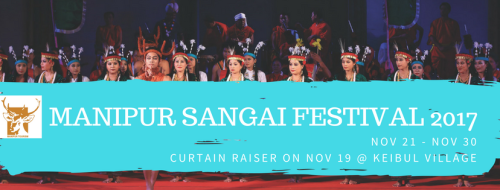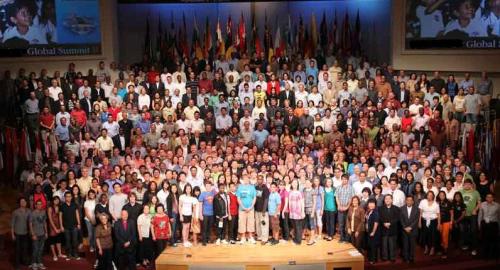Newspaper report says ‘the budget for organising Sangai Festivel 2017 was Rs. 7 (seven) crores’. Since the amount spent for the festival was huge and the fund was allocated from public money, it does make sense for any Indian citizen to ask the simple query – ‘Is Rs. 7 crores worth spending on the Sangai festival annually, and what does Manipur’s public gain or lose by having the festival?’ The best approach to answer this question is through having ‘a Sangai Festival Impact Study (SFI) framework tool’ that provides an objective and scientific analysis of the impact of each edition of the Sangai Festival. This approach will ensure every Indian citizen (esp. a Manipuri resident) to have a holistic perspective on the purpose of having the ‘Sangai Festival’ without the influence of any ‘political rhetoric’ and ‘biased views’ (which may been created because of the interests of few personals or groups associated with organizing the festival).

As a baseline, analysis of the impact study can be done under two scenarios – ‘with the festival’ and ‘without the festival’. In simple terms, these two scenarios means ‘Where could have we spent that Rs. 7 crores in case we didn’t have the festival and still achieve similar/better outcomes for Manipur’s public by having another project/programme instead?’ or ‘How best was Rs. 7 crores spent by conducting which specific activities as part of the festival, and how far those activities enabled realizing the essential impact factors as envisaged under overall objectives of having the festival?’. The word ‘tourism’, as per the Oxford’s English Dictionary, means ‘the commercial organization and operation of holidays and visits to places of interest’, and the specialized agency of the United Nations ‘World Tourism Organization (UNWTO) professes the simple definition of ‘sustainable tourism’ as ‘the tourism that takes full account of its current and future economic, social and environmental impacts, addressing the needs of visitors, the industry, the environment and host communities’. These two meanings highlight that tourism involves ‘management of certain activities involving money in a commercial setting’ and tourism activities ought to be made ‘sustainable’ for long term benefits especially for the local community’.
Compared to last editions of the Sangai Festival, there are few changes in the approach of how the Sangai Festival 2017 was organized, such as ‘new events at more venues (incl. those outside the usual venues within the Imphal municipal areas)’, ‘The SangaiRun to promote Loktak Lake and the Keibul Lamjao National Park’, ‘efficient usage of promotional means (incl. YouTube videos, dedicated websites, online ticketing system, publication on national print media, discussion on radio as well as TV showrooms, special invites to national and international delegates), ‘having the North East Development Summit at Imphal during the Sangai festival period and inviting the Hon’ble President of India to open the Summit’s ceremony’. It was laudable gesture that Her Excellency ‘the Governor of Manipur’ also adorned dress costumes of various ethnic groups in Manipur on various Sangai Festival events and hold heartedly championed those events. Visitors from outside Manipur (nationally and internationally) and local visitors to the event venues gave positive feedbacks about the activities of the Sangai Festival 2017 as well as possible improvements to the festival in future and limitations of the current 2017 festival. At the closing phase of the 2017 festival, the Hon’ble Chief Minister of Manipur also made an announcement regarding the intent of including more venues located in hill districts in the next Sangai Festival 2018 (such as cherry blossoms and flower festivals of Mao in Senapati district).
The Manipur State Government ought to engage a consultancy firm/institution that specializes in delivering impact studies of major projects/programmes by deploying economic and social research methodologies. Similar examples of such impact study report can be availed by searching ‘Olympic Games Impact Study’ on ‘Google Search engine’ (e.g. Pre-Games Report and Post-Games Report from the Economic & Social Research Council, UK). Such impact study report shows ingredients of what an impact study framework tool comprises. For a sustainable Tourism in Manipur, the Sangai Festival Impact Study (SFI) framework tool ought to be developed by identifying ‘pre-defined impact indicators’ spread across three internationally recognized areas of sustainable development – economic, socio-cultural and environmental. These indicators can be categorized into mandatory and optional, and each indicator ought to have a context (i.e. the area/topic of measurement) and an event indicator (i.e. the trigger / measuring factor). The period to be considered for measuring impact can be of three phases: Pre-Event (maybe covering ‘1 to 6’ months prior to the particular Sangai Festival), During-the-Event, and the Post-Event (maybe covering ‘1 to 6’ months after the particular Sangai Festival), and the duration of each phase may be considered appropriately.
Few possible indicators of the SFI under the economic agenda may be ‘employment by economic activity related to the festival’, ‘Tourist stay in private guest houses, and accommodation occupancy rate in local hotels’, ‘traffic at airport and bus/taxi terminals’, ‘size and number of not-for-profit/companies involved in the festival’, ‘nature of public spending during the festival and debts/expenses incurred by the State Government as part of the festival’, and ‘income earning of local people (incl. Emas/mothers at Keithels/markets) and those in the non-organized sectors’. Possible indicators of the SFI under the environment agenda may be ‘vehicle air pollution and surge of vehicle traffic due to the festival’, ‘solid waste disposal and public hygiene quality’, ‘utilization of local community and private resources (incl. ‘community halls, or equipment for meetings or leisure centers’ for a hiring fee)’, ‘utilization of Government owned public resources (incl. vehicles, auditoriums)’. The Socio-cultural agenda for the SFI may include indicators such as ‘poverty and social upliftment because of the festival’, ‘crime rates during the festival’, ‘volunteers to the festival’, ‘opinion polls on the festival’, ‘participation of local, national and foreign tourists’. Such indicators can be pre-designed for the current Sangai Festival and be improved (i.e. deleted/inserted) based on inputs from future festivals. By having a scoring system which is factually based on relevant data, we can have a holistic perspective of whether a particular Sangai Festival has been successful and up to what extent it has achieved the intended target points on each pre-defined indicator.
The Sangai Festival ought to bring about sustainable socio-economic development for the people of Manipur (esp. bringing positive impact to those at the bottom of the Pyramid in terms of economic parity and social inclusion). Infrastructures created as part of the Sangai Festival ought to be of multipurpose utility beyond the festival period by public and the event venues may be planned across various districts of Manipur State so as to leave behind valuable infrastructures for the local communities after the conclusion of the Sangai Festival of a particular year. This approach will support the socio-economic development agenda of the State Government, in addition to the intended tourism development agenda through the Sangai Festival. The Sangai Festival ought to have provisions of including the possible services of local population (i.e. private individuals as well as local clubs) so as to bring about socio-economic benefits to the local community in addition to those officially sub-contracted business people and corporate firms for the Sangai Festival. Active participation of local transport associations (of buses, wingers, auto-rickshaws) and private tour operators (incl. event organizers of various cultural and sports activities) ought to be provisioned in the plan for the Sangai Festival so that the ultimate benefits will be passed on to the public at large instead of few contractors associated to the Sangai Festival. What really is essential regarding the hoisting of such ‘Sangai Festival’ is to have an absolute clarity of ‘what the overall objectives are and the extent of festival’s scope’, because it is not a common sense approach to spend the large sum of Rs 7 crores to entertain ourselves for few days at the opportunity cost of investing the same amount on other valuable ventures such as ‘creating new coal-tarred roads, or new hospitals, or new school/college buildings, or new local micro-financing funds for uplifting poverty at villages’.
Indeed, the Sangai Festival can act as the platform for Manipuris (currently residing within Manipur and at various global cities) to get together and contribute towards the socio-economic development of the villages (and local communities) within Manipur, if we appropriately plan and execute the festival with a clear purpose to justify all possible opportunity costs. Otherwise, the festival will better serve the interest of few contractors and government officials (incl. ministers/MLAs) as compared to public at large in Manipur. Thus, it is essential that the state government creates an effective ‘Sangai Festival Impact Study (SFI)’ framework tool sooner than later so that there is clarity and transparency in the purpose of conducting the annual Sangai Festival by spending large sum of public money which could been spent on other relevant projects for the people of Manipur.
About the Author:
Shanjoy Mairembam (BEng, MBA, LLM) is an Innovation Consultant based at Leicester (UK). He supports mentoring of young entrepreneurs in ‘conceptualization of ideas into business case’, and offers role of a ‘Business Doctor’ to local NGOs/MSMEs in Manipur. For further info, visit http://www.shanmaiconsulting.com; E-mail: shanjoym (at) gmail (dot) com

